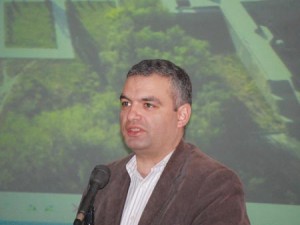Tamar Karkazian
Editor

Photo: Erica Magarian
The Armenian Genocide holds a special place in our hearts—every April Armenians come together to commemorate the loss of 1.5 million Armenians. Something that many Armenians connect to remembrance of the Armenian Genocide is the Armenian Martyrs Monument at Tsitsernakaberd. So it was a great honor to have Dr. Hayk Demoyan, Director of the Armenian Genocide Museum-Institute in Yerevan, Armenia visit Fresno State as a speaker in the Armenian Studies Spring Lecture Series.
During his talk on Monday, March 21st, he discussed the past, present, and future plans of the Museum – Institute.
Before Dr. Demoyan began his presentation, a video clip from “Stefani’s Armenia” was shown to the audience. Stefani is local news anchor Stefani Booroojian, who recently was invited to Armenia to report on the growing tourism industry. Her news clips, produced on the trip, were shown over a one-week period on the nightly KSEE24 broadcasts, and included one segment that had an interview with Dr. Demoyan.
The Genocide Museum-Institute consists of 3 main components: the Museum, Tsitsernakaberd (the memorial monument) and a commemorative forest. The Museum is dedicated and focused solely on the Genocide; it’s the only museum of its kind in the world. It contains lots of visual materials, photos, testimonials, as well as other artifacts. Many of these artifacts were donated by Armenian families to preserve history. The Museum has obtained so many items and exhibits that it will be expanded in the near future. In 2014 a new extension will be build to include classrooms, conference rooms, a library, and greater space for more exhibits.
Dr. Demoyan explained how the Museum is working with Armenian communities in major cities around the world to arrange for traveling exhibits on the occasion of the 100th anniversary of the Genocide in 2015.
The Tsitsernakaberd monument is the most known of the three areas. Annually, about 150,000 people from around the world come to visit this majestic monument. On April 24th over a million visitors pay their respects at the Monument, which was built in 1967.
The lesser-known area of the institute is the Memorial Forest. This is an area filled with trees planted by guest who pay official visits to Armenia, such as presidents, clergy, and political figures.
After describing the history of the Museum-Institute, Dr. Demoyan moved on to the “present” aspect of the institute. He went on to describe the exhibits at the Museum as well as events hosted throughout the year.
One such event is one that honors the unlikely or rather hidden heroes of the Armenian Genocide, such as Clara Barton from the Red Cross. This new tradition began in 1996 and still continues today. In 2007, the Institute began a website which is now available in 4 languages. Not only is it updated daily with new information but it is the excellent resource on the Armenian Genocide.
Dr. Demoyan described plans for the Centennial Anniversary Commemoration of the Genocide. “There is no distinction. We cannot select and divide ourselves… [the Genocide] is the main topic that unites us and we must work for the future.” And that is just what the Museum – Institute plans on doing.
The Armenian Genocide Museum-Institute is ready to support Armenians around the world with information and resources needed to get the word out about the Armenian Genocide. Their philosophy is one of a humanitarian approach versus a political approach. Their goal is to interrelate history so that others view it as a humanitarian issue, not an issue of politics.
 Hye Sharzhoom Armenian Action
Hye Sharzhoom Armenian Action